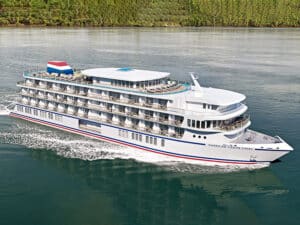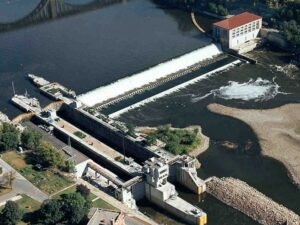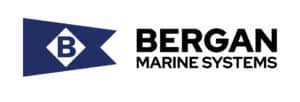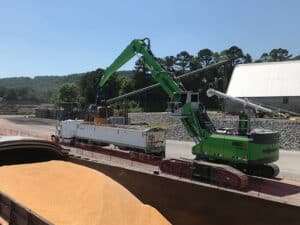
Missouri Governor hails Container-on-Vessel plan as visionary
Written by Nick Blenkey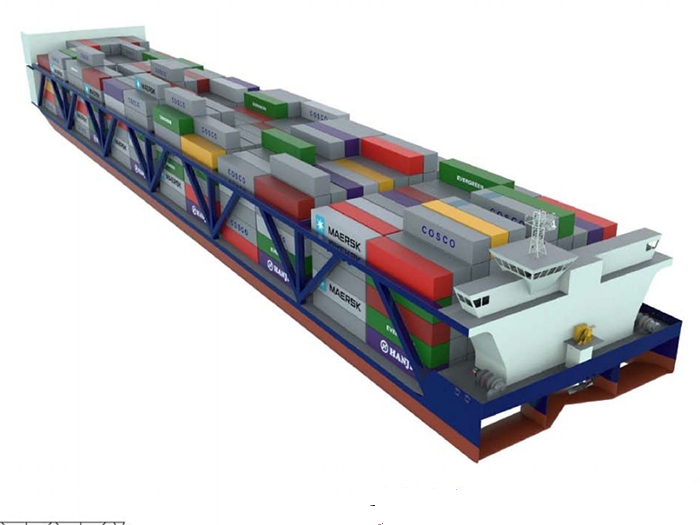
Planned next generation river container vessels have patented exo skeleton hull structure
Missouri Governor Michael Parson visited the Mississippi River town of Herculaneum, August 12 to find out more about statewide efforts to deliver a new option to transport freight along the inland waterways and what role an innovative waterway vessel could play in moving larger volumes of goods and commodities along both the Mississippi River and Missouri River and their tributaries. He was joined by a group of Missouri lawmakers, Jefferson County elected officials, representatives from the port authorities of Jefferson County, Kansas City and Jefferson City, and others.
The governor and lawmakers learned that Container-On-Vessel (COV) service is expected to reduce freight transportation costs and increase efficiency and reliability for shippers. After hearing a presentation about COV plans in Missouri, Parson recognized the potential statewide initiative as a visionary plan that could provide tremendous opportunity for Missouri.
“If you really look at Missouri and look at the ports we have running down both sides of the state – something no other state has – and you look at our highway system going north, south, east and west, and you look at our rail system spanning across the country to the east and west coasts, to Canada and Mexico, we have the ideal, prime location in Missouri to capture these kinds of investments in our state,” Parson said. “We’re going to put everything on the table that we can to find a solution.”
Taulby Roach, Bi-State Development President & CEO, spoke about the important role of Bi-State Development, through its St. Louis Regional Freightway enterprise, in creating the needed partnerships and collaboration between states.
“One of the biggest portions of that is, how do we create a cogency for the private sector to do better economic business within our state and the bi-state region,” said Roach. “That’s our job, that’s why I’m here today, and that’s why we’re looking to advance this project forward and gain Governor Parson’s and the Missouri Legislature endorsement on this idea.”
Mary Lamie, Executive Vice President of Multi Modal Enterprises at Bi-State Development, talked about the expectation for freight volume to increase by 40% in the next three decades and the importance of the Midwest capturing a part of those increased freight volumes. She also said changes in global trade patterns are impacting how containers are moving in and out of the United States, creating an opportunity for vessels to become a huge gamechanger as they continue to grow larger and larger. Among the types of commodities that can move in containers on these larger vessels – for the State of Missouri and for this region – are seasonal furniture, appliances, construction material like ceramic tiles, various other imports and exports and containerized soybeans. Refrigerated products like beef and pork may also be an option.
“Our region has earned the status of having world-class freight network based on national rankings,” said Lamie, who leads the St. Louis Regional Freightway for Bi-State Development. “We’re the third largest inland port, third largest rail hub in the nation and one of the most competitive and efficient inland port systems in the nation. In 2017, we branded our region as the Ag Coast of America and that’s based on the fact that nowhere else on the Mississippi River has the capacity for barge handling of fertilizer and agriculture products that we do, and that’s based on those freight assets.”
Seeking to connect more freight via the inland waterways to those freight assets, Lamie has been engaged on the COV effort, and recognized the need to partner with sister cities like Kansas City and Jefferson City within the State of Missouri, as well as with ports in the State of Louisiana and with IDOT, MoDOT and the U.S. Department of Transportation to help advance the idea.
“We know that as a nation we’re lagging behind in infrastructure and what we’re trying to do today is better maximize the existing modes of transportation,” said Lamie. “The inland waterway system obviously is under-utilized, and this is a tremendous opportunity for not only our region, but the State of Missouri to take advantage of these growth opportunities that are taking place with freight.”
Sandy Sanders, Executive Director of the Plaquemines Port Harbor & Terminal District, where the Gateway Terminal for the new COV service would be developed, provided additional insight on those opportunities.
“In 10 years, there’s going to be a 10 billion ton increase in maritime cargo,” Sanders said. “If that cargo is going to the Gulf Coast, you need a true gateway port.”
He added that the Gateway terminal, with the ability to accommodate a 20,000 TEU ship and connect with all the modes of transportation in the Midwest, is unlike any other in the nation, and will give beneficial cargo owners optimal options to move their cargo.
Sal Litrico, Chief Executive Officer, American Patriot Container Transport LLC (APCT) discussed COV as a necessary change to bring added value to the supply chain, creating a new, lower cost transportation option for Midwest cities.
“We’re implementing a whole new system that starts with a strategic, state-of-the-art Gateway Terminal, linked to strategic state-of-the-art container terminals in the Midwest, connected by innovative and patented vessels that carry critical mass at the lowest landed cost on an all-water route, providing significant savings to shippers without compromising reliability,” said Litrico.

